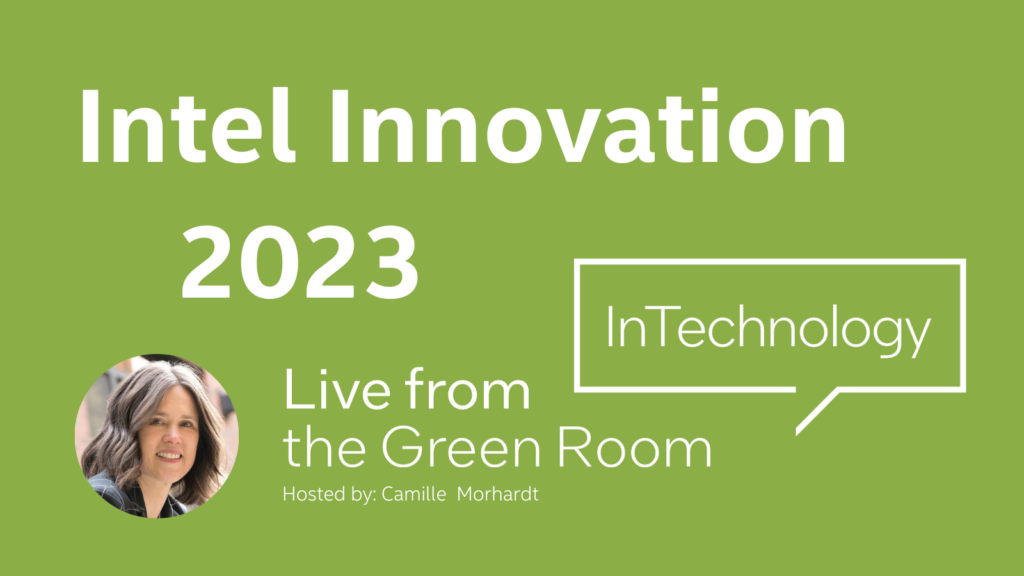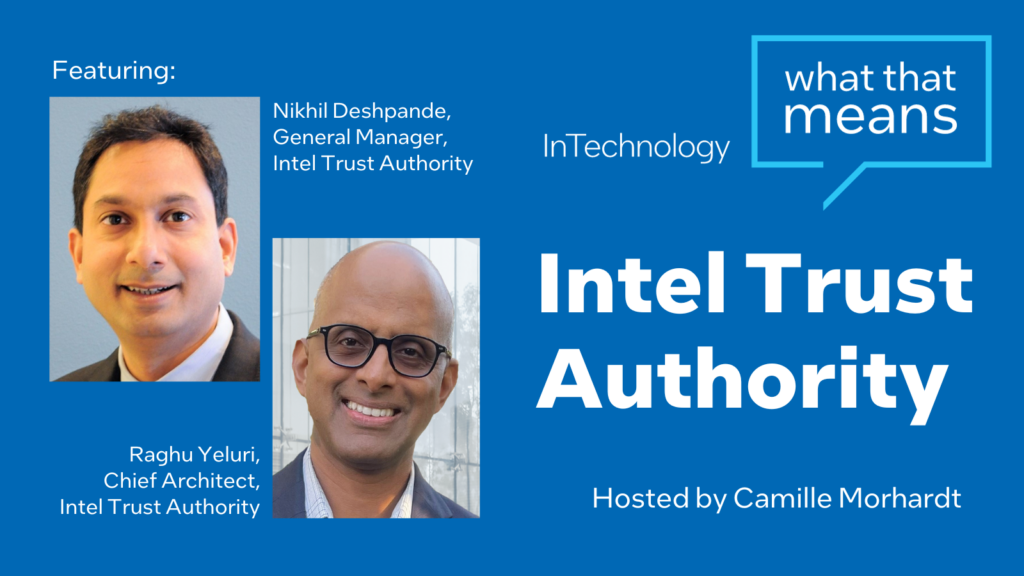Ep163 – WTM: Virtual Reality and Augmented Reality
[00:00:36] Camille Morhardt: Hi and welcome to In Technology Podcast. I have with me today Slava Podmurnyi. He is CEO of Visartech and this company does, among other things, augmented reality and virtual reality. So we’re gonna talk about What That Means, the future of AR/VR; and we’re also gonna dive into some of the applications that his company works with around EdTech and e-learning.
Welcome to the show, Slava.
[00:01:04] Slava Podmurnyi: Hello Camille. Thank you for invitation and it’s a pleasure to share some of my knowledge with your audience.
[00:01:10] Camille Morhardt: Thanks for joining us all the way from Berlin today. I know your company is based out of Delaware, but you’re on business travel, so appreciate the time zone juggling and whatnot.
[00:01:20] Slava Podmurnyi: No, no worries.
[00:01:22] Camille Morhardt: If somebody’s never heard of it, or maybe somebody’s heard of VR but they don’t really know what it is other than sort of goggles and a better experience or something to do with Meta. What kinds of things are VR and AR used for? What’s the difference between VR and AR and really just like, what is it? How does it work?
[00:01:03] Slava Podmurnyi: For me, it’s additional layer of reality. We have comparing to real world. In real world, we perceive information, we are able to get it, but at the same time we use computers. It’s also like some sort of additional layer of reality. VR and AR brings the same information we see on our displays but it brings it in a more immersive way. In a way you can collaborate with that data and use it more efficiently more in natural way.
[00:02:08] Camille Morhardt: What’s difference then between virtual and augmented reality?
[00:02:11] Slava Podmurnyi: So inside virtual reality, you are fully immersed inside virtual environment. So you are inside some sort of experience. Imagine like a movie theater and you are watching the movie and you see just the screen and everything else is black. So it’s virtual reality. If you’re talking about augmented reality, imagine like real world, but you just see, for example, my avatar in front of you. So it’ll be like augmented reality, just additional layer on top of real world.
[00:02:39] Camille Morhardt: Can you explain how the Metaverse is put together? Is that classified as VR or AR?
[00:02:45] Slava Podmurnyi: I wouldn’t say it’s even connected to VR and AR. Again, like VR and AR, it’s a method of seeing things. You can see the same things using your display, your laptop, your phone, for example. And Metaverse is just a virtual world. So the world, you can be inside some sort of virtual environment.
I like example, like compare metaverses to games, but sometimes in games, I dunno, like you play Slacker, for example? Or you can just chat to other people or fish together or do any other activity.
[00:03:17] Camille Morhardt: Okay. So it’s immersive in a different world. Is there gonna be anything else on this continuum? That’s emerging? I mean, I’ve heard AR and VR for a long time now, so is there another one that’s coming?
[00:03:31] Slava Podmurnyi: Uh, probably not. Like in, in the latest Apple developments, for example, they just mix it. So you’re able to add more virtual reality or add less virtual reality for some experiences. So, there were like a term called “mixed reality.” But again, people stopped probably using that because it’s basically the same.
[00:03:50] Camille Morhardt: I was just watching the ad for the Apple VR goggles. I’ll call them goggles. I don’t know what, what they’re officially called.
[00:03:58] Slava Podmurnyi: Vision Pro probably.
[00:03:59] Camille Morhardt: There we go. Yeah. Vision Pro.
[00:04:01] Slava Podmurnyi: In Apple’s concept, you can see everything as you see with your eyes. Just add some sort of like additional layer like a visual display, for example, or a visual person. Right now we’re using some software to communicate using the video calls and we see each other. But imagine we just use those goggles and see each other as avatars in real room or in virtual office, for example. It’s much more immersive and much more realistic for our brain.
[00:04:27] Camille Morhardt: And when that happens, like are the gestures that I’m making real time actually incorporated into the avatar?
[00:04:34] Slava Podmurnyi: It depends on headset. If we’re talking about Apple recent innovation and technology, yes; they have gestures tracking and they have face tracking, eye-tracking sensors. So basically you’ll see like some sort of like digital reconstruction of our real bodies. And yes, we’re able to change our outfits, you know, have no problems with, I don’t, our shirts and our backgrounds.
[00:04:57] Camille Morhardt: And, and it doesn’t, we don’t have to center it on Apple, but I mean, how do these devices work? How do the goggles work? They’re shining something in to do gesture tracking or eye tracking, like what exactly is happening inside of that goggle?
[00:05:10] Slava Podmurnyi: If you’re talking like evolutionary about those devices, the first ones were two separate displays which were displaying some information closer to your eye. And with use of special lenses, you get it like more in, in immersive way. If you use your phone and put it close to your eyes, it won’t work, yes, you’ll see almost nothing; but with special lenses–magnifying lenses– you’ll see it’s like between you and your eyes, for example.
In recent devices, uh, they use a set of outside cameras and inside cameras and maybe some additional sensors to show you the image for example–outside cameras, to track movements and the environment, which is crucial. Yes, you don’t want to hit a wall or have an injury and they use some internal cameras to track your eyes and maybe some face gestures as well.
[00:05:56] Camille Morhardt:So what is something that would surprise people about AR or VR right now?
[00:06:02] Slava Podmurnyi: You will get much more information at the same time. I like to say, you know, like in TV, like you have frames. So in one frame of your brain you’ll get much more data; at the same time, you’ll be able to see, probably at night you’ll be able to see things you are not able to see with your vision. I believe like there is a huge potential from medical implementations where patients with vision problems will get much more information they really need to, because otherwise they are not able to see that.
[00:06:34] Camille Morhardt: I didn’t know about the seeing at night. That makes perfect sense. Can you give us an example of something that your company Visartech is doing in this space right now?
[00:06:44] Slava Podmurnyi: We have one medical startup at the moment. We have a cooperation with a doctor who uses virtual reality to help in patients’ rehabilitations–especially patients with severe brain injuries. He helps them to rewire their brains, so they regain ability to see their, again, ability to move properly with special exercises inside the virtual reality. So you can see that medicine and rehabilitation will become much more affordable with those technologies.
[00:07:14] Camille Morhardt: Yeah, it’s interesting to me, personally, because I think it was about fifteen years ago or something, I went up to shadow a physician–I think it was University of Washington–but he was using virtual reality to help kids who had been burn victims in fires. Really unfortunate. Very, very painful and they have to change the dressings and the wounds, and that’s a very painful experience also. And they were trying to offer kids an opportunity to use less drugs possible, right? because they’re still developing brains and whatnot.
And so they found that if they gave the kids these VR headsets and they gave them peaceful environments–I think the one that I saw was like, it wasn’t even very realistic, again, this is like over a decade ago, but it was like a snow scene and because, you know, trying to create some cool–and the kids could like, lob snowballs back and forth with a snowman or something, and the kids had control over their own pain medication, I, I suppose, up to a limit or something.
But they found that the kids in these headsets were using like up to 90% less pain med because their brains were so distracted with the game and they felt more at peace. I mean, that was like a long time ago. So I can imagine now it’s come a long way.
[00:8:32] Slava Podmurnyi: Actually, we had similar example collaborating with London-based startup, and they were doing some sort of like present environments for patients who are not able to like non-curable patients, you know, like in, in serious status where they only can lay all the time. And those patients also showed much better performance results. Uh, even they start using less medicine. Uh, their attitude to life improve because they’ll be able to see the world, they’ll be able to walk again. So it’s, I believe it’s a huge difference if you talk about medicine implications.
[00:09:07] Camille Morhardt: OK, so now I want to ask you about securing these things. Now I’ve got cameras pointing in toward me collecting probably it can identify that I’m me because my eyes are unique. But besides that, it’s also looking, can tell where I’m looking, can probably tell my emotional reaction to what I’m sensing. And then also now if I’m walking around my house, it’s not just that it’s allowing me to see kind of past the overlay that they have of–they as in whoever’s making the goggle right–the overlay of the application or the screen that’s dropped in front; it’s actually videotaping or video recording what I would be seeing.
So now there’s like a video of my home, right? So help me understand how we deal with this.
[00:09:56] Slava Podmurnyi: It’s definitely a problem, if you’re talking about privacy and security, and we just need to rely on the data protection of those company and data regulation acts of governments. So yes, that is true. They basically record everything and they hear everything you hear. Even with current like smartphones? Yes. Like they’re able to hear and see a lot. With VR they’ll be able to see those headsets, they’ll be able to see everything.
[00:10:22] Camille Morhardt: Okay. So I guess essentially you’ll wanna, if you’re gonna purchase one of those as a consumer or business, you would just wanna know that and be aware. Also, I suppose if you’re interacting with somebody who has one on know and be aware that it could be recording you as well in that interaction.
[00:10:40] Slava Podmurnyi: At the same time, we receive much more information and we are able to interact with the information in more efficient ways. So I would say it’s the progress. People were scared about first cars and the first cinemas and I would say it is the same. Remember Europe before the smartphones it was totally different world. And now we’re okay that they’re recording us. I mean, not okay, in general. Yes. We invent those acts. We try to protect our privacy. At the same time. It works and it works pretty well.
[00:11:08] Camille Morhardt: And how is this going to interplay with artificial intelligence? I mean, it’s a massive data collection mechanism, right? We just discussed cameras pointing out and pointing in. So how is that going to overlay with like biometric data that’s been collected?
[00:17:31] Slava Podmurnyi: It’s impossible without AI; it’s already uses a lot of AI mechanisms like in order to use those cameras before the cameras, there were like some special sensors on a wall, but it was bulk set up and no one would probably use it like that professional VR. Now they use just cameras and computer vision to determine obstacles and, um, some other stuff outside the camera. And same for inside cameras, they’ll definitely use AI to catch your emotions, your eye position, because based on where you’re looking at inside the VR, they optimize those applications to give you a better picture, more immersive experience, and so on.
Answering about data protection and, gathering data, they’ll probably, those like headset manufacturers, they’ll gather all possible data. They’ll understand where you’re looking at which advertisements you see, which things, uh, attract your attention. Basically everything. At the same time, get your medical information. I mean, it, it’s the same like now we use smartphones, we use some, uh, headsets. We use, uh, Apple watches for example. They help a lot of people with medical conditions, even to call emergency services. So definitely those like headsets will help to us to be in more secure environment. But the price is definitely, they’ll get all the data from us. That’s true.
[00:12:50] Camille Morhardt: So who owns the data then? If we get to the point where I’m looking through the goggle, but you know, I’m essentially operating this device; is it like location based, you know, if I’m in my home, I own the data? or if I’m at the office or a job site, then they own the data? or …
[00:13:09] Slava Podmurnyi: It’s the same probably as with smartphones. The manufacturers, they definitely store some data, probably let’s hope impersonalized. So they just use it for technical reasons and for statistics. And definitely the business owner–for example, if you are a worker at the factory and you use AR goggles with a special software made for this factory–so definitely the business owner or this factory will get all the data you see and use because its business.
Based on the experience of using information data and Data Protection Act, probably there will be like some sort of regulations if you do not want that people read your face, there will be like some sort of limitation in the software—a on your social network, you can select some sort of options that I don’t want to be visible for people outside of my network. Yes, and so probably some kind of regulations from the government, definitely.
[00:14:02] Camille Morhardt: Your company, Visartech is using AR and VR to help with EdTech, right? Education technology, and e-learning. So can you talk to us about how you address security within those spaces?
[00:14:16] Slava Podmurnyi: I wouldn’t say there’s something different connecting to VR and AR and security. So basically like if you have any educational application, where you can then learn a language, uh, there’s no big difference. You still need to encrypt the data. You need to make sure that you have a safe infrastructure; you need separate some personal data with some impersonalized data, maybe separate payment gateways and so on. Definitely make security audits all the time to make sure you’re well protected.
[00:14:44] Camille Morhardt: Can you give us a sense of how rapid adoption is in those spaces? And are there obstacles to overcome that, especially in the case of children?
[00:14:55] Slava Podmurnyi: Yes, definitely. There are some obstacles. Uh, a lot of current headsets, they have some age limitations. For example, Facebook’s Meta Quest headset, they have limitation like 13, but recently they downgraded it to 10 years. I have a son, he’s eight, and he uses VR a lot. I mean, in reasonable amount, of course.
The biggest challenge for kids is to maintain the headset itself because it’s still big, it’s still bulky. And, it may be sort of like expensive for schools. Headsets, the cheapest one is like around like $300. There are other applications and some companies still uses, you know, like some simplified headsets like Cardboards still, because there are so much cheaper and so much easier to maintain. And still kids are able to see much more inside virtual reality. They are able to be inside the volcano. They’re able to see all those processes in 3D, so it’s much more immersive. So they’re inside the science, uh, which is great for them.
[00:15:55] Camille Morhardt: Does your company work with children specifically or more with industry?
[00:16:01] Slava Podmurnyi: Uh, we mostly work with businesses and businesses who work with, kids. But still, we have testers. We have testers at home and we get some feedback from schools. Uh, and kids are interested; they like new technologies and they’re so much more native in those comparing to us.
[00:16:19] Camille Morhardt: Where would you like to see the technology go? How are you excited personally to see it evolve? Are you looking forward to like implants inside of, you know– I would love a contact lens where I could pop it in for my night vision camping experience, and then take it out when I, yeah.
[00:16:38] Slava Podmurnyi: Yeah, if we’re talking about like some sort of implants, it’s really kind of scary because you don’t want any electronics inside your brain, but at the same time, maybe it’s, it’s definitely the future. At some point we’ll reach that out, I hope. Right now probably the biggest problem is that like, people don’t really like to, we are like even eyeglasses, um mm-hmm. We’re talking about some electronic devices covering the whole vision of you. So it’s the biggest problem of their real devices right now.
[00:17:06] Camille Morhardt: Why are these goggles so thick and are we, you know, is the next phase like thinner goggles or overlay within glasses? Or is it actually just, you know, a contact lens? Or are we gonna get all the way down to a chip implanted somewhere inside of us so that there is no kind of external device?
[00:17:25] Slava Podmurnyi: Yeah, I mean, definitely it’ll get thinner and probably at some point will be inside our brain; so we will have nothing to wear. If I remember, like the first Google Cardboard, it, it was basically like a cardboard where you put your smartphone and you see through it. So it was bulky; and in the first version, there were even no straps and no buttons at all. So, It wasn’t too easy to use.
The current generation is much thinner. It almost looks like normal goggles and I believe like next generation will be just, you know, like sunglasses. And the next one probably will be more like lenses or even some sort of implants probably.
[00:18:01] Camille Morhardt: What kinds of applications are you seeing demand for AR and VR?
[00:18:07] Slava Podmurnyi: If we’re talking about education, definitely the ability to show for students more processes. They’re able to be inside a volcano and they’re able to be inside the working engine, for example; they able to be outside in space like astronauts. So they able basically to see so much more and more they see, more educated, they are.
If we’re talking about industry, for example, you have a person who sorts some sort of goods in your manufacturing factory, and, uh, you want to improve their efficiency. So the only way to do so is to give them AR goggles and highlight some products so they can do it much faster, much more efficient, and with less error.
[00:18:48] Camille Morhardt: So for training purposes?
[00:18:50] Slava Podmurnyi: No, no, no. Not for training. I mean for training, as well, but, uh, also for actual production, imagine you’re an engineer and you inspect a production line for any problems. And with AR goggles, you can instantly see the blueprint. You can understand the problem. Some sensors from the production belt may alarm you that like, in this place, particular, “I have a problem, please check me out.” And engineer sees through the metal. Again, it’s like additional layer of reality, which gives us a lot of information we’re not able to see in real life.
Automotive, it’s a huge opportunity for designers to collaborate. Engineers overviewing production line. Because right now a lot of industries, they do like digital twins of their factories in order to optimize those factories in order to make it safer environments, do some trainings. And simply improve the production line and improve their business.
[00:19:42] Camille Morhardt: Explain what a digital twin is.
[00:19:45] Slava Podmurnyi: Digital twin is basically exact copy of, I don’t know, imagine a factory and digital twin is exact copy of that factory inside, uh, simulated environment. So you have all those machinery, you have all those business processes, you have all those, manufacturing process, happening inside simulated environment; and you’re able to simulate and see maybe some logical errors in production. You’re able to train your staff to behave better in case of some emergencies. Basically, you do whatever you want to simulate any occurrences, any changes to that production, and see the output result without putting billions of dollars, uh, into real changes.
[00:20:26] Camille Morhardt: And I can definitely see how you could run, machine learning algorithms on the, sort of speed up the process and simulate something that might occur either positive or negative.
[00:20:38] Slava Podmurnyi: It’s a good point. Definitely you can do this and uh, you can simulate different scenarios. For example, you can like make an assumption, “okay, I want to improve the belt one, uh, I want to improve output from like 500 items per hour to 800 items per hour by adding another equipment; you add it into digital twin, you see the output and there may be an error. Yes. You won’t be able to do that in real life, for example. And you can do this path of like trials and errors and get like the most pleasant result.
[00:21:12] Camille Morhardt: Do you think within five years everybody will have some sort of a headset or glasses or implant?
[00:21:19] Slava Podmurnyi: (laughs) Probably not implant definitely, but, uh, I believe in five to 10 years there will be no like displays, no laptops; we’ll have some sort of glasses and, uh, there will probably, there will be no smartphones, probably even in course of 10 years. We’ll see. There will be like a lot of different applications and technologies. So it’s really interesting to see that making progress in that build.
[00:21:45] Camille Morhardt: So just wondering when you think we might achieve the Star Trek version of virtual reality. Is it on the horizon?
[00:21:53] Slava Podmurnyi: It’s a good question. Uh, I thought about that probably, based on my assumptions, within like probably 20 to 30 years, we’ll definitely be able to do that. Not so far away.
[00:22:22] Camille Morhardt: Okay. Will we be doing time travel by that time also?
[00:22:09] Slava Podmurnyi: Uh, probably not. It’s like more like complicated quantum problem than just a simulated environment.
[00:22:16] Camille Morhardt: Well, Slava, thank you very much for the conversation. I find it extremely interesting, the future of AR and VR, so thanks for talking through it and the security implications.
[00:22:27] Slava Podmurnyi: Thank you for opportunity to share my knowledge and the experience.




